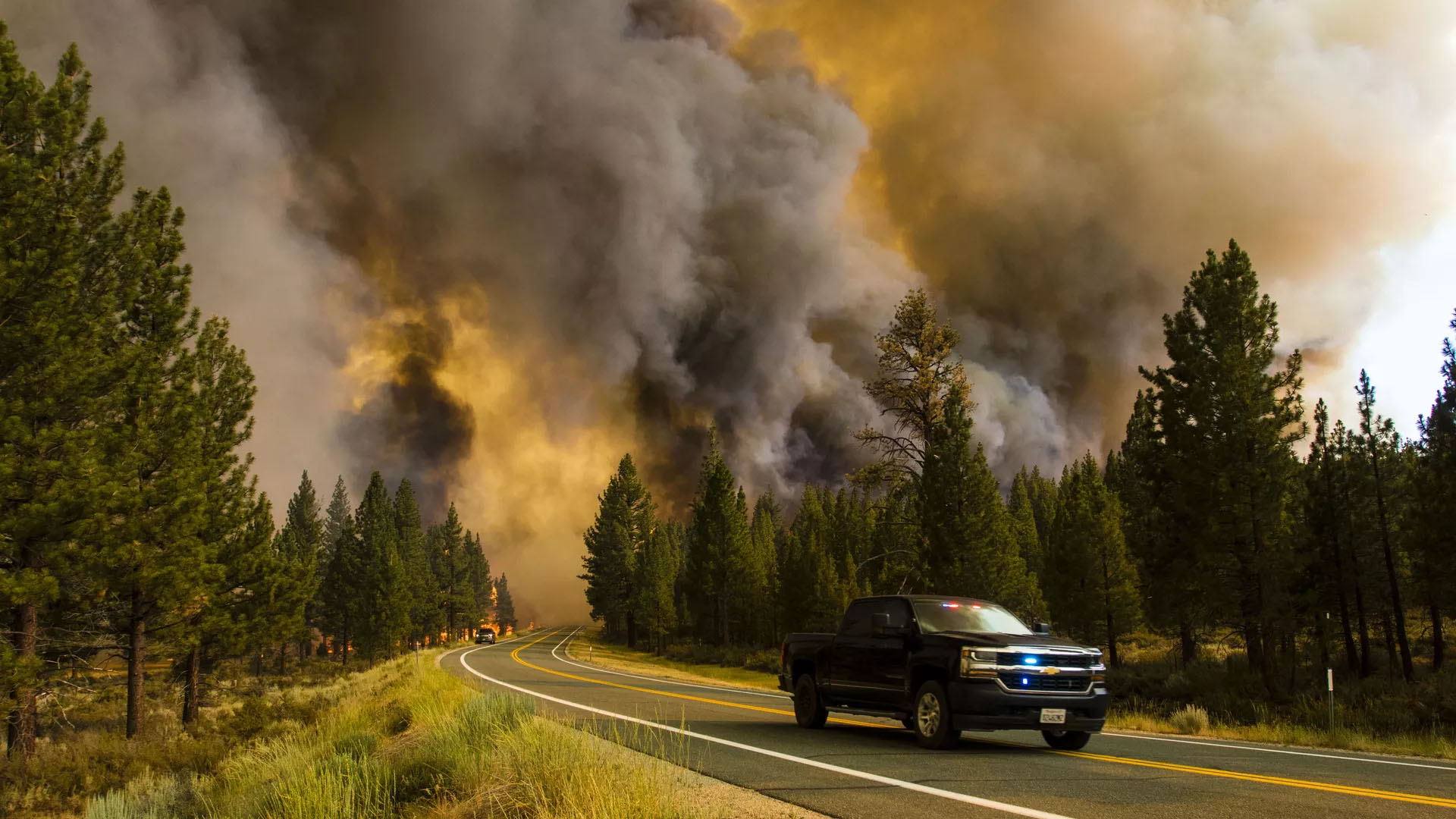Climate Migration Comes Home
A review of Abrahm Lustgarten, “On the Move” (Farrar, Straus and Giroux 2024)

Published by The Lawfare Institute
in Cooperation With

The sky was burnt orange and the smoke was coming. If the fire advanced through the buffer zone, it would reach his California town and then his porch. He suddenly understood why Ellen from down the road was considering fleeing to somewhere like Vermont, if she could only find the right house. This was different from his reporting on Syrians seeking refuge in Europe or Central Americans looking for safety across the U.S. border; this was climate migration hitting home.
Abrahm Lustgarten, an investigative reporter writing about climate change at ProPublica and for the New York Times, opens his latest book with this personal anecdote about the deadly 2020 California fire season. It’s a fitting curtain-raiser to a book that compellingly frames climate migration as not only an indirect security risk for U.S. foreign policymakers to consider but also a pressing issue for today’s U.S. residents.
It is this former perspective on climate-related mobility—as a destabilizing factor abroad—that takes priority in the U.S. policymaking apparatus. For example, the October 2021 White House Report on Climate Migration focuses nearly entirely on displaced people outside of the U.S. The National Intelligence Council warns that climate impacts could push “poor Central American farmers” into cities or toward the southern U.S. border. The most prominent climate migration bill considered by the present Congress proposed creating a new category of foreign “climate-displaced persons” who could be eligible for admission into the U.S. (There is no clear legal definition of a “climate refugee,” nor are people displaced by climate change covered under the 1951 Refugee Convention.)
With both Republicans and Democrats working to restrict the existing right to asylum, the outlook for the U.S. to significantly expand its availability to climate-displaced people around the world is not great. In the near term, the U.S. will likely continue to use stopgap measures to spare some climate victims from removal or deportation, such as the Temporary Protected Status available to citizens of select countries that have suffered an environmental disaster.
But at a time when U.S. cities are getting so hot that Arizona burn centers are filling up with patients injured by falling on scalding pavement, there’s real value in what Lustgarten has published: a well-written, informative analysis of how climate change is shaping where Americans can live. “On the Move” ably weaves together Lustgarten’s personal reporting with his analysis and write-ups of academic studies.
In his review of the fires, floods, and other climate impacts that will drive migration, Lustgarten deserves credit for avoiding the temptation to overuse the most extreme and unlikely scenarios for global heating (known as RCP 8.5)—the projections for a moderate emissions scenario (RCP 4.5) are worrying enough. More and more Americans are facing heat and humidity so stifling that the body cannot cool itself down by sweating, turning air-conditioning from a comfort item to a necessity. When extreme weather knocks out power during a heat wave, as Hurricane Beryl did for 3 million Texans in July, those people become temporary climate migrants, forced to seek cooling services in football stadiums or churches.
More insidious and lasting than heat waves are the effects of sea-level rise, which could displace more than 13 million coastal Americans over the course of the century. Government efforts to facilitate withdrawal to safer areas in the face of now-unavoidable climate change, like the Federal Emergency Management Agency’s (FEMA’s) plan to relocate residents of Newtok, Alaska, away from thawing permafrost and a flooded coast, are a sign of the federal government’s becoming more proactive and doing more than providing costly disaster aid. Officials at the Department of Housing and Urban Development have their own plans for “community-driven relocation,” described as a [climate] resilience action of “last resort.” The U.S. Pentagon may be able to plan to spend nearly $5 billion to protect bases, like Tyndall Air Force Base in Florida, from flooding and storms, but this budget won’t be there for every U.S. citizen living in harm’s way.
Agriculture, like the Americans who practice it, is particularly vulnerable to climate impacts. By hearkening back to the Dust Bowl of the 1930s, Lustgarten reminds the reader that environmental change has driven migration within the U.S. before, and we should expect it to do so again. He writes up a University of Chicago-NASA study warning of a “systemic decline in production” for the farmers of the Great Plains, whose aquifers are running dry and whose corn, soy, and wheat are vulnerable to rising temperatures.
Yet misguided government policy sometimes sets up perverse incentives for those affected: The reader hears from farmer Greg Wuertz, who grows cotton in the Arizona heat. Wuertz could save water by growing lettuce instead. The problem is that doing so would cause him to lose $100,000 in farm bill subsidies because of how the aid is calculated, with past crop production as a baseline. So he keeps growing cotton, making the regional water crisis worse.
Lustgarten nods briefly here to the potential for climate impacts in the U.S. to develop into the men-wielding-guns type of security threat that is often the proximate driver of climate migration in fragile countries in the Northern Triangle of Central America. One pathway is for droughts to elicit government restrictions on water or grazing lands (e.g., around the parched Colorado River), which so enrage affected government-skeptic groups that they deploy force to get their water and their way. (Consider the case of the Bundy militia, which in 2014 got into an armed standoff with federal officers over grazing rights.) With U.S. troops increasingly deploying domestically to deal with the fallout from extreme weather, the same climatic forces that are undermining agriculture and contributing to migration are also burdening the U.S. military.
Lustgarten has a knack for using individual examples to elucidate systemic problems. When he tells the story of lawyer and climate justice organizer Colette Pichon Battle, explaining how climate change is making it difficult for her family to hold on in the Louisiana bayou they’ve called home for 15 generations, he is getting at a larger question: What happens when the state can’t afford to build enough levees and dams to protect a whole region? And what happens to the culture of those who have to retreat from their homeland?
He also points out how past injustices are complicating responses to climate impacts. Some Black owners who acquired property during Reconstruction did not keep legal deeds in courthouses for fear that white investors would steal their property; their descendants now have issues accessing FEMA aid.
Not all of the book is about the U.S., and the international passages add good context. Lustgarten recounts his research in Guatemala and why people risk the treacherous journey to the U.S. border. The reader is reminded that border walls are an international phenomenon; India has mostly finished one along its 2,500-mile border with Bangladesh. The reader is invited to consider parallels between emigration from climate-stressed North Africa and climate-stressed Florida. In both cases, the departees are likely to be on average younger and/or better-resourced, which raises concerns about the outlook for the populations who stay.
Occasionally, though, Lustgarten does leave the reader wanting more. One section explains how government-subsidized flood insurance and cheap water mask “indispensable” price signals and incentivizes Americans to live in dangerous places. They also inhibit effective climate policy “because there’s no pressure to address the risk. What would drive voters to call their representatives and demand climate action more than a direct, costly gut punch to their savings account?”
It’s a sharp recommendation, but Lustgarten never squares it with the other sections that advocate “managed retreat” from homes in flood zones or lament the “spiraling cultural and economic consequences” of the collapse of farming in drought-hit areas. How should the government balance competing goals of protecting cultural heritage, reducing the cost of state insurance and disaster aid, avoiding racial discrimination in disaster aid payouts, and ensuring adaptation projects pass a cost-benefit analysis? While it’s not fair to expect “On the Move” to definitively answer such tricky questions, the text sometimes dips into policy recommendations and then returns to reportage before the proposals are followed to their conclusion.
Additionally, it would be helpful if a few more of the assertions were sourced. Lustgarten writes that “the number of people moving away from high-risk climate regions is growing,” with no citation. But Redfin analysis of Census Data shows that the counties most exposed to floods and fires gained more population than they lost in 2022 and 2023. Indeed 11 of the 15 fastest-growing large cities in the country are in Texas, Florida, and Arizona.
One of Lustgarten’s more astute observations is that many people in climate-vulnerable areas have an interest in playing down the climate impacts that can lead to migration. If you’re selling condos in Miami or running for mayor in Charlotte, there’s little benefit in acknowledging the problems on the horizon. It’s much easier to ensure that homeowners know little about flood risk and keep getting subsidized insurance, so that development continues today and becomes someone else’s problem in the 2030s.
In this vein, the book describes an interesting study that found some first signs of climate change in the mortgage market: Some banks are “knowingly offloading climate liabilities” by packaging loans on homes threatened by sea-level rise to government entities Fannie Mae and Freddie Mac. More recent research argues that “US residential properties exposed to flood risk are overvalued” by at least $121 billion. Indeed, the market for homeowner’s insurance has crumbled just in the four years since Lustgarten stood watching a forest fire from his porch—giant insurers like State Farm have stopped offering new homeowner’s insurance policies in California, and government efforts to force insurers’ hands cannot remove the underlying risk. In the end, someone always pays for extreme weather.
In the book’s final section, Lustgarten engages with scientific models that predict where Americans might live in 10 or 20 years—for some regions, climate change might be a boon, at least in relative terms. The Great Lakes region, with its cool summers and ample fresh water, could become a climate refuge, providing opportunity for southerners moving north, reminiscent of the Great Migration of Black Americans in the mid-20th century. Agricultural yields may rise in the North even as they decline in the Great Plains.
In sum, “On the Move” offers worthwhile reading. Lustgarten’s book stands alongside other good, recent efforts to depict and analyze climate migration in the U.S., such as Susan Crawford’s “Charleston: Race, Water, and the Coming Storm” or Jake Bittle’s “The Great Displacement.” It allows the reader to see climate migration in all its facets, as a consequence of how humans have transformed the earth and turned the atmosphere into a blanket, as a cause of human mobility from Texas and California to Bangladesh or Honduras—and, importantly, as a security risk.
Climate-related migration threatens not only to destabilize the world in ways that can undermine U.S. security but also to create pockets in this country where security cannot be provided, where it is too hot for police to patrol on foot, where angry farmers are striking back against state officials trying to control their dwindling water supplies, and where the steady rise of the salty sea will send service providers scrambling to safety long before the remaining residents give up on their family homes.



